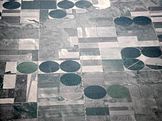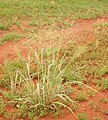Portal:Agriculture
The Agriculture Portal

Agriculture encompasses crop and livestock production, aquaculture, and forestry for food and non-food products. Agriculture was a key factor in the rise of sedentary human civilization, whereby farming of domesticated species created food surpluses that enabled people to live in cities. While humans started gathering grains at least 105,000 years ago, nascent farmers only began planting them around 11,500 years ago. Sheep, goats, pigs, and cattle were domesticated around 10,000 years ago. Plants were independently cultivated in at least 11 regions of the world. In the 20th century, industrial agriculture based on large-scale monocultures came to dominate agricultural output.
As of 2021[update], small farms produce about one-third of the world's food, but large farms are prevalent. The largest 1% of farms in the world are greater than 50 hectares (120 acres) and operate more than 70% of the world's farmland. Nearly 40% of agricultural land is found on farms larger than 1,000 hectares (2,500 acres). However, five of every six farms in the world consist of fewer than 2 hectares (4.9 acres), and take up only around 12% of all agricultural land. Farms and farming greatly influence rural economics and greatly shape rural society, affecting both the direct agricultural workforce and broader businesses that support the farms and farming populations.
The major agricultural products can be broadly grouped into foods, fibers, fuels, and raw materials (such as rubber). Food classes include cereals (grains), vegetables, fruits, cooking oils, meat, milk, eggs, and fungi. Global agricultural production amounts to approximately 11 billion tonnes of food, 32 million tonnes of natural fibers and 4 billion m3 of wood. However, around 14% of the world's food is lost from production before reaching the retail level.
Modern agronomy, plant breeding, agrochemicals such as pesticides and fertilizers, and technological developments have sharply increased crop yields, but also contributed to ecological and environmental damage. Selective breeding and modern practices in animal husbandry have similarly increased the output of meat, but have raised concerns about animal welfare and environmental damage. Environmental issues include contributions to climate change, depletion of aquifers, deforestation, antibiotic resistance, and other agricultural pollution. Agriculture is both a cause of and sensitive to environmental degradation, such as biodiversity loss, desertification, soil degradation, and climate change, all of which can cause decreases in crop yield. Genetically modified organisms are widely used, although some countries ban them. (Full article...)
Selected article

A business producing tree fruits or nuts is called an orchard; a vineyard produces grapes. The stable is used for operations principally involved in the training of horses. Stud and commercial farms breed and produce other animals and livestock. A farm that is primarily used for the production of milk and dairy is a dairy farm. A market garden or truck farm is a farm that grows vegetables, but little or no grain. Additional specialty farms include fish farms, which raise fish in captivity as a food source, and tree farms, which grow trees for sale for transplant, lumber, or decorative use. A plantation is usually a large farm or estate, on which cotton, tobacco, coffee or sugar cane, are cultivated, often by resident laborers. (Full article...)
Selected image

Did you know...
General images
Related portals
Topics
Categories
Things you can do
- – When a task is completed, please remove it from the list.
WikiProjects
Associated Wikimedia
The following Wikimedia Foundation sister projects provide more on this subject:
-
Commons
Free media repository -
Wikibooks
Free textbooks and manuals -
Wikidata
Free knowledge base -
Wikinews
Free-content news -
Wikiquote
Collection of quotations -
Wikisource
Free-content library -
Wikiversity
Free learning tools -
Wiktionary
Dictionary and thesaurus
Agriculture journals

- Agronomy Journal - the American Society of Agronomy
- Agronomy for Sustainable Development Journal
- European Journal of Agronomy
- Journal of Agronomy and Crop Science
- Journal of Organic Systems
- Agriculture, Ecosystems & Environment
- Agriculture and Human Values
- Computers and Electronics in Agriculture
- Precision Agriculture
- Experimental Agriculture
- Journal of Integrative Agriculture
- Journal of the Science of Food and Agriculture
- Renewable Agriculture and Food Systems
- Biological Agriculture & Horticulture
See also:



































































